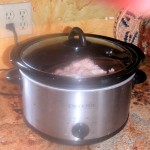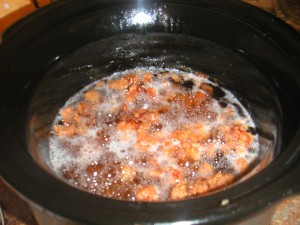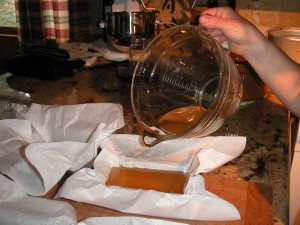text and photos by Catherine Haug
Back in July I posted Rendering Lard – the Perfect (& Original) Shortening, which covered the following topics:
- What is Lard
- What’s Good about Lard? (a comparison of lard vs vegetable shortenings)
- Rendering Lard (links to other instructional websites)
- Storage & Shelf Life
- Where to Obtain Lard for Rendering
In this post, I detail the process that Shelli R. and I used to render 10 pounds of pork fat from Farm to Market Pork. We decided to try the crockpot method following instructions in “Livin’ High on the Hog: How I Rendered my own Lard“, and take photos along the way. We did this in Shelli’s kitchen using three crockpots.
Printable version of this article: Rendering Lard in a Crockpot (pdf)
Equipment required
Collect all your equipment before starting:
- crockpot(s)
- cooking thermometer that will read at least 260° F
- slotted spoon
- colander or large strainer
- good quality cheesecloth
- large glass or stainless steel bowl with pour-spout (do not use plastic)
- bread pans or other molds, or glass canning jars with lids
- parchment paper (not needed if using jars)
- freezer paper & tape (not needed if using jars)
- towels
- oven mitt
The process
We started with two 5-pound blocks of pork fat, and ended up with a little more than 4 pounds of rendered lard.
Render the fat in the crockpot(s)
We unwrapped the blocks of pork fat, which included bits of meat and connective tissue, and divided it between our 3 crock-pots. Here’s the last bunch of fat to be put into the pot:
Here’s the fat in the crockpot:
NOTE: Some instructions add water to the fat, to help prevent scorching, but this makes the process stink, so we opted not to add the water.
Set the temperature control to low, to begin melting the fat. Stir the fat occasionally to keep it from scorching, but remember that every time you remove the lid, you cool off the crock, so don’t overdo.
Eventually the fat will begin to bubble and the cracklings will begin to fry. The mixture will be about 200° F, and you want it to reach 260° F. However most crockpots will not achieve this on low, so when it starts to bubble, increase the heat to high and give it a good stir. It takes a minimum of 9 hours to reach this temperature; ours took longer because we left the crockpot on low longer than we needed.
We noted that only the crockpot used in these photos got up to 260° F (the Original Crock-Pot Slow Cooker (R)). The other two (Rival brand) only got up to 235° F.
[The reason for 260° is to ensure all the water has boiled off, per Joe Pastry website(see comments)].
When the mixture reaches 260° F, it is ready for straining.
Strain the rendered fat
Line a colander or mesh strainer with good quality cheesecloth (use double layer if the mesh is fairly loose). Set this over a large bowl with pour spout. We put a towel in the bottom of Shelli’s sink and set the bowl and strainer on top of the towel. This was to protect her glass bowl from the shock of hot fat against the cold porcelain sink.
Shelli picked up the crock using an oven mitt, and poured off the fat and cracklings into the strainer.
We let this sit for awhile, to allow all the fat to drip through the strainer.
Pour into jars or molds
While the lard could be stored in canning jars, we decided to make blocks of lard that could be wrapped for freezing. We used small bread pans as molds, and lined them with parchment paper to protect the hot fat, and for ease in removing the solid fat from the molds.
Note that the hot fat is amber in color:
However when it cools and solidifies, it is a creamy white:
[NOTE: Joe Pastry: How to Render Lard (in the oven) has another great idea: Use muffin tins. He didn’t line his tins; just poured into them directly, put the tins into the freezer, then when frozen, transfered them to plastic bags.]
Prepare for storage
If you want to store your lard in jars, it’s best to pour it directly into jars while the lard is still hot, and screw on the lids. As the hot fat cools, the lids will seal, the same as with canning.
If you want to freeze it, it is best to pour into molds as we did, then transfer to the refrigerator to harden (room temperature lard is soft and not so easy to wrap). Then wrap in freezer paper, and label with the date.
We divided the blocks evenly between us, about 2 pounds each. I decided to wrap two of my blocks in freezer paper for freezing, and transfer the third to a jar for refrigeration. All are labeled with the date:
You can save the cracklings, if you like them, or compost them. Per Shelli’s suggestion, I will refrigerate my share of the cracklings for my cats. Like Shelli’s dogs, my cats LOVE them, and its good for their skin and fur, too.
Shelli’s Suggestions
Unless you need a lot of lard at the same time, Shelli suggests doing only one crock-pot full at a time, rather than 3 pots full like we did.
To save energy, she suggests doing this in the oven (300º F) when you are doing a roast so both are in the oven at the same time. You will need to consider that having two roasting pans in the oven will require longer roasting time, and your lard may need to remain in the oven longer than your roast.
Sources
- “Livin’ High on the Hog: How I Rendered my own Lard“
- Farm to Market Pork, Kalispell MT
- Joe Pastry: How to Render Lard (in the oven)










Hi, I did end up saving the cracklings. I fed a couple to my dogs and they LOVED it. So I’m going to ration them out over a period of time. Did you want some for your cats?
Thanks a million! for the concise, straightforward information. Much appreciated.
My daughter and I just finished rendering suet into tallow from the fat of a local grass-fed beef. We used an 18 quart electric roaster oven and purposely kept it set no higher than 225 degrees. So I was curious why your article insisted on reaching 260 degrees during rendering.
Judy,
we were following instructions from a blog (Livin’ High on the Hog), that said 260. But it seemed to be OK only getting to 235.
Another site also says 260: (http://joepastry.com/index.php?cat=140)
It says, “until the lard reaches a temperature of 255 – 260 degrees (mine took five hours). This is the temperature at which all the water will have boiled out, leaving nothing but the pure lard.”
He added water to his fat, but we didn’t add water, so that’s probably why we were OK at 235. Did you add water to the suet?
BTW, great suggestion to use a roaster – similar to a crockpot but on a larger scale.
Very good article. One question: At what temperature does lard ignite?
Veronica H asked via email: What is the temperature does lard ignite?
Cat responds: Good question. I don’t know the answer but will research.
OK, there are 3 temperatures pertinent to your question: smoke point, flash point, and fire point.
— The smoke point of lard is about 370 F (Wikipedia), and is the point at which the fat begins to break down such that the fatty acids separate from the glycerol backbone.
— The flash point of lard is 480 F (Materials Handbook); this is the point at which it will ignite, but will not sustain a flame.
— Fire point is the temperature at which it will sustain a fire after ignition; I cannot find that temperature for lard.
Rendering lard in a crockpot is thus quite safe since heating to 260 F is well below the flash point and thus should not lead to a fire. That is, unless your heating device is faulty.